5.2 Nationalism and Revolution
The American Revolution
Economic ideas played a part in the American Revolution, providing a defense of free market ideas (capitalism) in opposition to English mercantilism.
Politically American colonists had become increasingly independent with colonial legislatures making decisions usually made by Parliament, since great distances separated colonists from Parliament and the king in London.
Economic and political desires for independence grew
July 4, 1776: Declaration of Independence expressed the philosophy behind the colonists' fight against British rule (Day independence was declared not given.)
In the war that followed, colonists triumphed in 1783 with crucial help from Britain's long-time enemy, France.
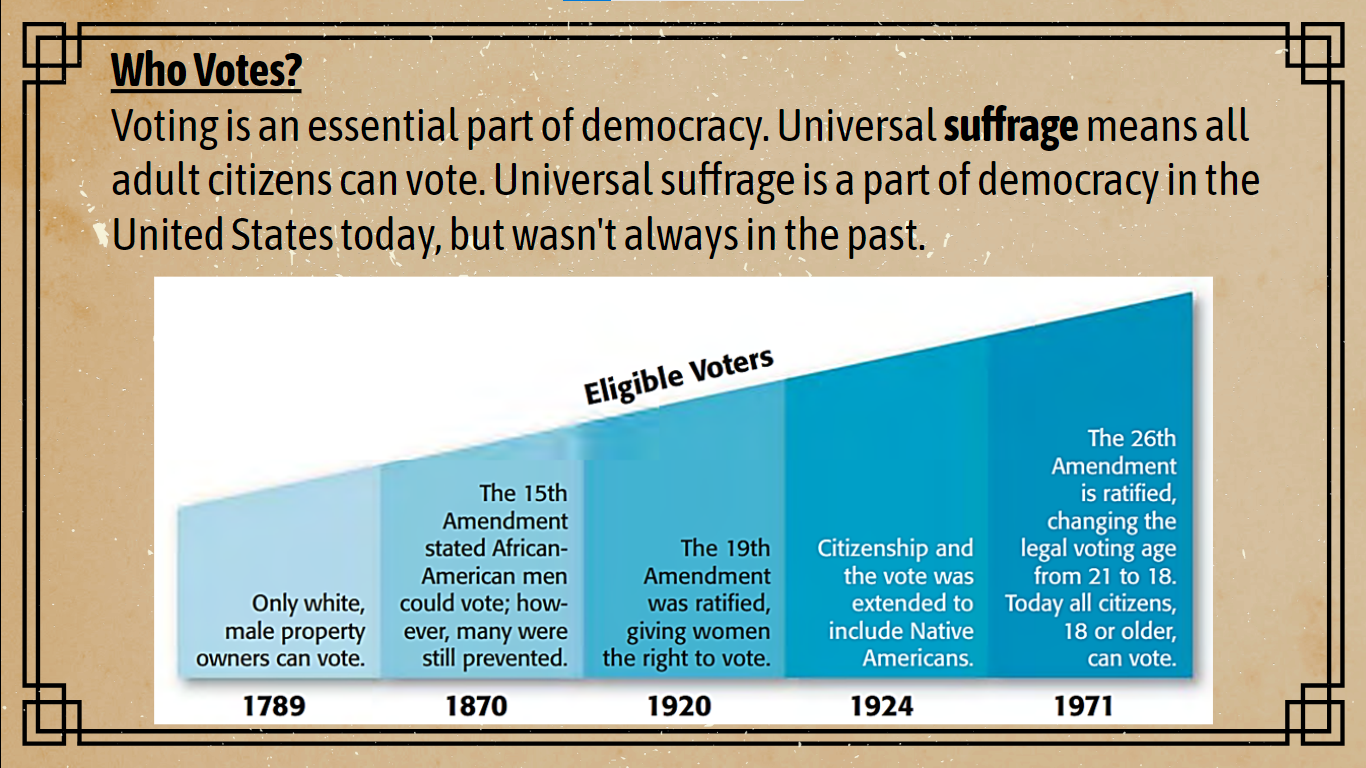 Chart of Eligible Suffrage
Chart of Eligible SuffrageThe New Zealand Wars
-Maori will live in New Zealand for hundreds of years until British arrive
In 1840 the colonization of the British caused English control over Maori affairs, as did pressure for their land.
-British wanted Maori to submit their land
These issues resulted in a series of wars between the Maori and British collectively known as the New Zealand Wars.
1872: Though the Maori tribes fought together, developing a sense of Maori nationalism the British had won.
The French Revolution
1780s: In France revolutionary ideals took on their own spin, summarized in the slogan liberté, égalité, et fraternité (liberty, equality, and fraternity).
These ideas, which many people saw as radical, were popularized throughout Europe in the writings of the philosophes.
The Enlightenment will speak out to the lower class
The Estates General with meet to address their financial situation (French government)
Three sectors of society, or estates, made up the Estates-General: the clergy (religious officials), the nobility, and the commoners.
Commoners can’t vote, caused them to break away and create a new body, the National Assembly
The National Assembly meeting in Paris, and king threatened to arrest the leaders.
Angry crowds rioted in Paris and elsewhere in France
French Independence Day “Bastille Day” (Prison) Peasants stormed the Bastille let the prisoners go, some royal officials fled France. The king was forced to accept a new government with a National Assembly in charge
July 14, 1789 became French Independence Day
Permanent changes were enacted early in the Revolution:
Feudalism will be abolished, no more serfs.
-Adopted the Declaration of the Rights of Man(basic human rights)
1792: Louis XVI and nobility refused to accept a limited monarchy, dissatisfying radical groups (Jacobins) and inspired the establishment of the First French Republic
Reign of Terror:Period in which the government executed thousands of opponents of the revolution, including the king and queen, led by the Jacobins.
1804: After a period of turmoil and war, the brilliant general Napoleon Bonaparte became the emperor of France.
Haitian Revolution
-Slave led Revolution
End of 18th century: Revolutionary forces influenced rich French sugar and coffee colony of Haiti.
Slaves revolted against white masters, killing them and burning their houses. This slave revolt was joined by escaped slaves (Maroons).
1791: American and French revolutions inspired former slave Toussaint L'Ouverture to join the revolts who lead a general rebellion against slavery.
Besides being well-read in Enlightenment thought, L'Ouverture proved to be a capable general.
His army of enslaved Africans and Maroons established an independent government and played the French, Spanish, and British against each other.
1801: After taking control of the territory that would become the independent country of Haiti, L' Ouverture produced a constitution that granted equality and citizenship to all residents.
He also declared himself governor for life.
Land reform: Plantations were divided up, with lands being distributed among formerly enslaved and free black people.
L'Ouverture worked with the French but they betrayed and imprisoned him. He died in France in 1803.
He cemented the abolition of slavery in Haiti, and lead to independence from France.
1804: L'Ouverture's successor, Jean-Jacques Dessalines, orchestrated a Haitian declaration of permanent independence.
Haiti became first country in Latin America to win its independence and first black-led country in the Western Hemisphere.
It was the only country to become permanently independent as a result of a slave uprising.
Creole Revolutions in Latin America
Latin American mainland: Revolutionary ideals were taken up by creoles.
Born of European ancestry in the Americas, creoles (criollos) were well educated and aware of ideas behind the revolutions in North America and France.
They considered themselves superior to mestizos, who were born of European and Indian parents.
At the bottom of the social ladder were African slaves, indigenous population, and mulattoes, those of African and either European or indigenous ancestry (some of these social distinctions remain today.)
Colonists born in Spain or Portugal (peninsulares), felt superior to everyone.
Fearing the masses, the creoles refused the support of mestizos, indigenous people, and mulattos
The creoles had seen the slave uprising in Haiti and excesses of the French Revolution during the Reign of Terror.
Some creoles, like Simon Bolivar, continued to push for Enlightenment ideals in Latin America.
He became instrumental in the independence of areas that became Venezuela, Colombia, Ecuador, and Peru.
1783: Born in Venezuela (ancestor of village aristocrats in Spain
They grew wealthy in Venezuela, giving Bolivar access to wealth for his revolutionary causes.
His military success against the Spanish led to creation of Gran Colombia, hoping it would become a federation similar to United States (based on Enlightenment ideals).
Described himself as a liberal who believed in a free market and abolition of slavery.
New nations of Latin America suffered from long wars of independence.
Armies loyal to their generals led to rise of caudillos: strong, local leaders with regional power bases.
These men intervened in national politics, some defending interests of regional elites and some indigenous population and peasants
In general they disregarded representative forms of government and the rule of law.
Constitutions of the newly independent countries in Latin America legally ended some social distinctions and abolished slavery, but governments were often conservative.
Example: First constitution of Peru forbade voting by those who could not read or write in Spanish, effectively denying most indigenous people the vote (constitution was changed in 1860).
Creoles continued to form a powerful and conservative upper class, as they had before the wars of independence from the European nations.
Women gained little from revolutions in Latin America, were unable to vote or enter into contracts, received little education, most remaining submissive to men.
Manuela Saenz (1797-1856): Lover of Bolivar, actively participated in fighting alongside Bolivar.
An excellent rider, courageous fighter, she rose to the rank of colonel and on one occasion saved Bolivar's life, receiving the nickname "Liberator of the Liberator."
Going to rise to the rank of a kernel in his army
1868: Puerto Rico and Cuba some of its last colonies, held uprisings against Spanish rule.
Many individuals and organizations contributed to the revolution in Puerto Rico, the role of Lola Rodriguez de Tia was unique.
A poet during an era of little educational opportunity for women, Rodriguez de Tia became famous for her critiques of Spain's exploitive rule over Puerto Rico.
Her home was a meeting place for political thinkers and revolutionaries
1868: Uprising forced Rodriguez de Tio into exile in Venezuela.
1885: She was allowed to return, but her critical writings led to exile, this time in Cuba.
She wrote and worked for Cuban independence, earning her exile from there too (to New York).
1899: She returned to Cuba and spent her remaining years as a campaigner for social justice there.
Propaganda Movement
The Philippines remained a Spanish colony in the 19th century.
Educational opportunities, even for well- to-do Filipinos, were limited and controlled by religious authorities, leading many young men (creoles and mestizos) from wealthy families traveled to Europe, especially Madrid and Barcelona, to attend universities.
The nationalism and republicanism inspired by Enlightenment thinking in Europe was embroiled by these Filipino students.
José Rizal: Became prominent among these young agitators, who contributed to magazines and pamphlets advocating for greater autonomy for the Philippines.
Propaganda Movement: Did not call for revolution or independence, but Spanish authorities viewed its members with suspicion.
Rizal's arrest (1892) and execution (1896) shocked Filipinos and helped spur the first nationalist movement with the organization and strength to challenge Spanish rule.
1896: With a serious military upheaval the Philippine Revolution began
Nationalism and Unification in Europe
As nationalism spread beyond Europe and the Americas, people often created an identity under one government where none had existed before.
Nationalism: Common bond among people that shared the same language, history, and customs.
Thrived in France and areas conquered by Napoleon, particularly Germanic areas of declining Holy Roman Empire.
Nationalism was a unifying force that threatened large empires and united people who shared a culture into one political state.
Nationalism and Unification- Italy
Count di Cavour (Prime minister of Piedmont- Sardinia): Led effort unite entire Italian Peninsula under the only native dynasty (House of Savoy).
The region was divided into kingdoms and city-states, and most people spoke regional languages rather than Italian (Cavour spoke French better than Italian).
As a liberal, he believed in natural rights, progress, and constitutional monarchy, but also in realpolitik: practical politics of reality
1858: He persuaded France into a war with Austria, hoping to weaken Austrian influence on the Italian Peninsula.
After winning two important battles, France backed out in fear of the Pope (not eager for Papal States to come under control of a central Italian government).
It was too late to stop revolutionary intensity, and several areas voted to join Piedmont (the Kingdom of Sardinia).
Cavour allied with Red Shirts led by Giuseppe Garibaldi, fighting farther south in the Kingdom of Naples.
Nationalism and Unification- Germany
Nationalist movements had strengthened as a result of opposition to the French occupation of German states under Napoleon I (Bonaparte).
1815: Following the Congress of Vienna (ending Napoleonic Wars) revolutions occurred in several European states, including Prussia and Austria.
1848: Revolutions resulted from nationalism (desire for independence) and liberalism (desire for representation under constitutions that recognized civil liberties).
Otto von Bismarck: Prussian leader who favored realpolitik, used nationalism to engineer three wars to bring German unification.
He persuaded Austria into two wars, one with Prussia against Denmark (1864) and one between Prussia and Austria (Seven Weeks' War, 1866).
After winning both, Bismarck manipulated France into declaring war against Prussia, and his armies beat the French soundly in the Franco-Prussian War (1870).
In each of these three wars, Prussia gained territory.
1871: Bismarck founded the new German Empire made up of territories gained from the wars, like Alsace-LorraineNow two new powers, Italy and Germany, created competing alliances.
Balance of power would be achieved briefly through alliances, but extreme nationalism would lead to World War I.
Nationalism and Unification in Europe- Ottomans
17th century: The dominant force in southeastern Europe for centuries, saw the beginning of its long slow decline.
1683: The failed attempt to conquer Vienna was the beginning of success by Austria and Russia in rolling back Ottoman dominance in the Balkans, with Balkan nationalism rising with Western influence
1800: Greece had been under Ottoman control for more than 350 years, but increased contact with Western ideas meant exposure to Enlightenment principles, and helped reawaken Greek cultural pride and stoke the fires of Greek nationalism.
An extended civil war against Ottoman forces brought some success.
1827: The intervention of a British, French, and Russian fleet, which destroyed an Ottoman fleet, helped assure Greek independence.
Events in other Balkan regions followed (Serbia, Bulgaria, Romania).
Waning Ottoman control led to greater freedom and influx of new ideas, including nationalism, with people rallying around important cultural markers, such as language, folk traditions, shared history, and religion.
Outside powers (Russia or Austria) aided in achieving independence
1870s-1880s: Development of Ottomanism: The movement aimed to create a more modern, unified state.
Officials sought to minimize ethnic, linguistic, and religious differences across the empire, taking control of local schools and mandating a standard curriculum.
Ethnic and religious groups within the Ottoman Empire had nationalist feeling and viewed Ottomanism with suspicion, leading to people's feelings of difference and promoting their desire for independence.
Nationalism and Unification in Europe Results
Unification did not solve all Italian troubles.
Poverty in Italy, more in the south than in the north, led to considerable emigration (leaving of a country) in the late nineteenth century
Most went to the United States and to Argentina (where the constitution of 1853 specifically encouraged immigration).
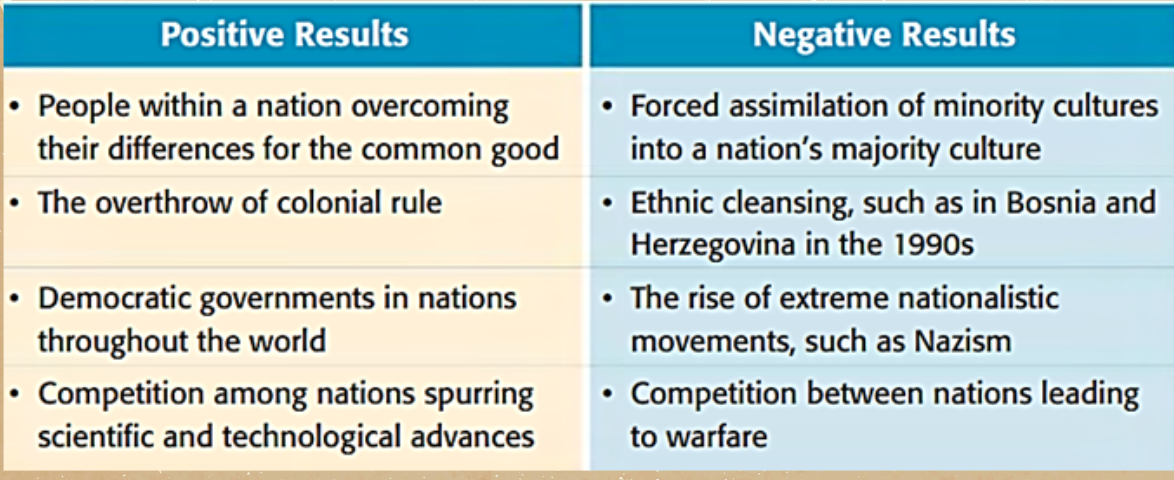
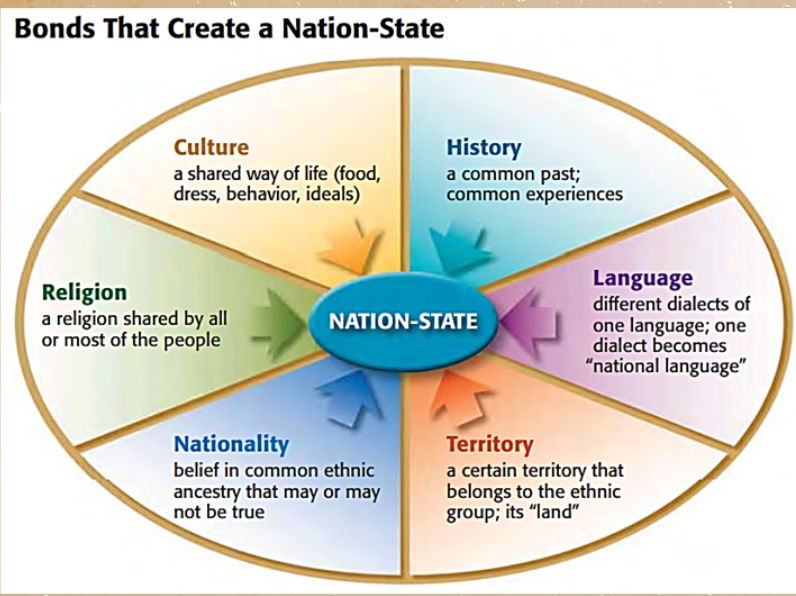
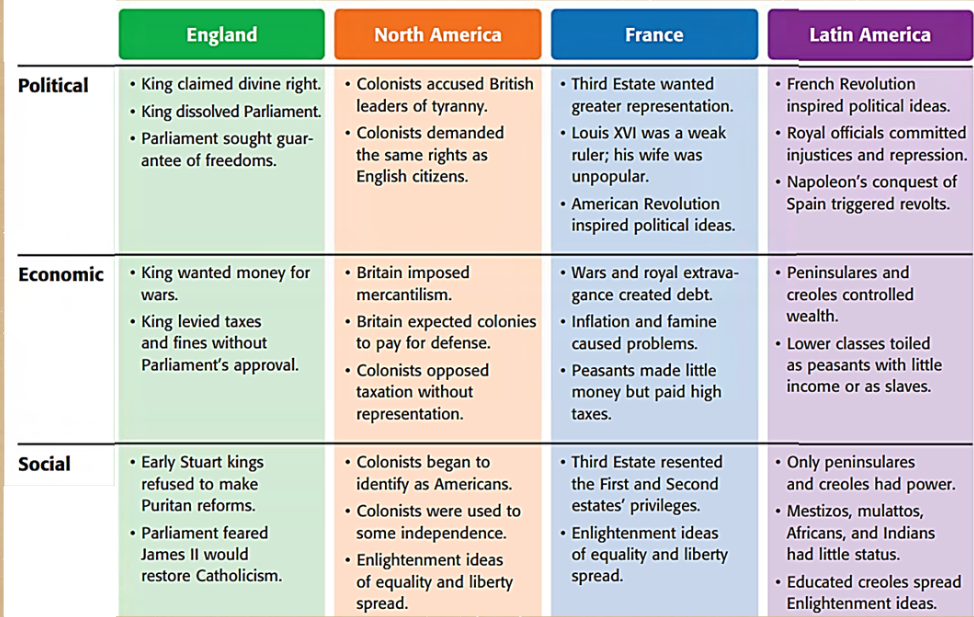 Causes for Revolutions
Causes for Revolutions
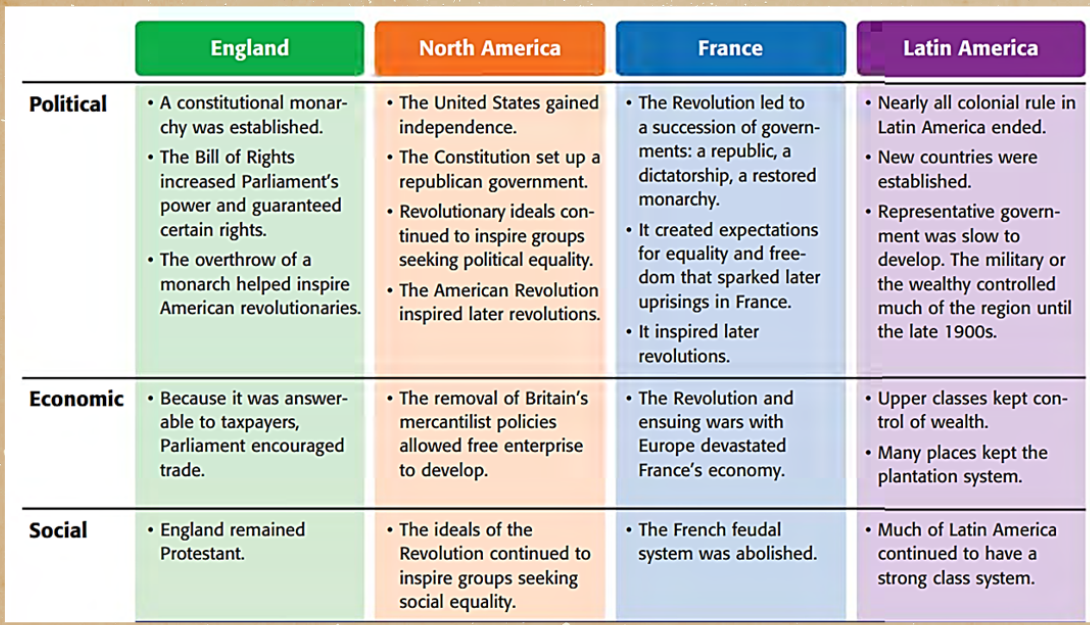 Effects of Revolutions
Effects of Revolutions